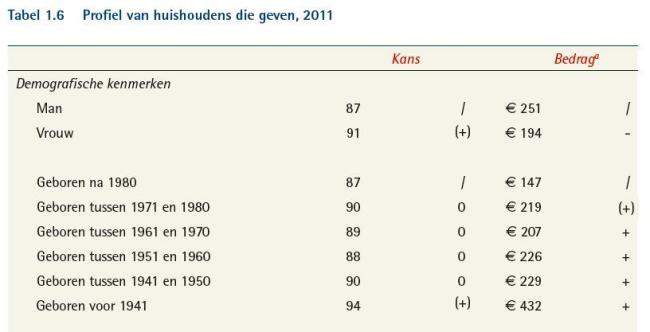Ralph-Friso Belksma, student in de master Public Administration in Leiden, schrijft:
“Voor een onderzoek voor mijn studie ben ik op zoek naar enkele gegevens met betrekking tot geef gedrag. Ik kan hier alleen moeilijk gegevens over vinden. Vandaar mijn vraag: Geven vrouwen meer geld uit aan goede doelen dan mannen? Hoe oud zijn zij en hoeveel geld geven zij gemiddeld uit?
Ik had deze gegevens graag in 1 tabel willen zien. Het verbaasde mij dat deze gegevens zo moeilijk te vinden zijn.”
Toch mooi dat we deze gegevens allemaal in 1 tabel hebben staan in ons laatste Geven in Nederland-boek.
We zien:
- Vrouwen geven (iets) vaker, maar lagere bedragen.
- Ouderen geven vaker, en ook hogere bedragen.
De vergelijking van mannen en vrouwen in deze tabel is overigens niet erg informatief. Het gaat om het geslacht van de respondenten in ons onderzoek die antwoorden over het geefgedrag van het hele huishouden. Je zou eigenlijk alleenstaande mannen en vrouwen moeten vergelijken en rekening moeten houden met verschillen in mogelijk verstorende factoren zoals leeftijd, opleidingsniveau, aantal kinderen en inkomen om te weten of vrouwen en mannen van elkaar verschillen. Huishoudens maken vaak (impliciet) gezamenlijk beslissingen over giften. Het kan best iets uitmaken wie de macht heeft in die besluitvorming, zo suggereert Amerikaans onderzoek. In Nederland lijkt dat minder uit te maken, zo vond ik samen met Pamala Wiepking in eerder onderzoek.

